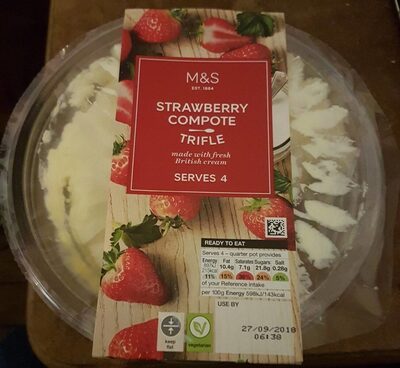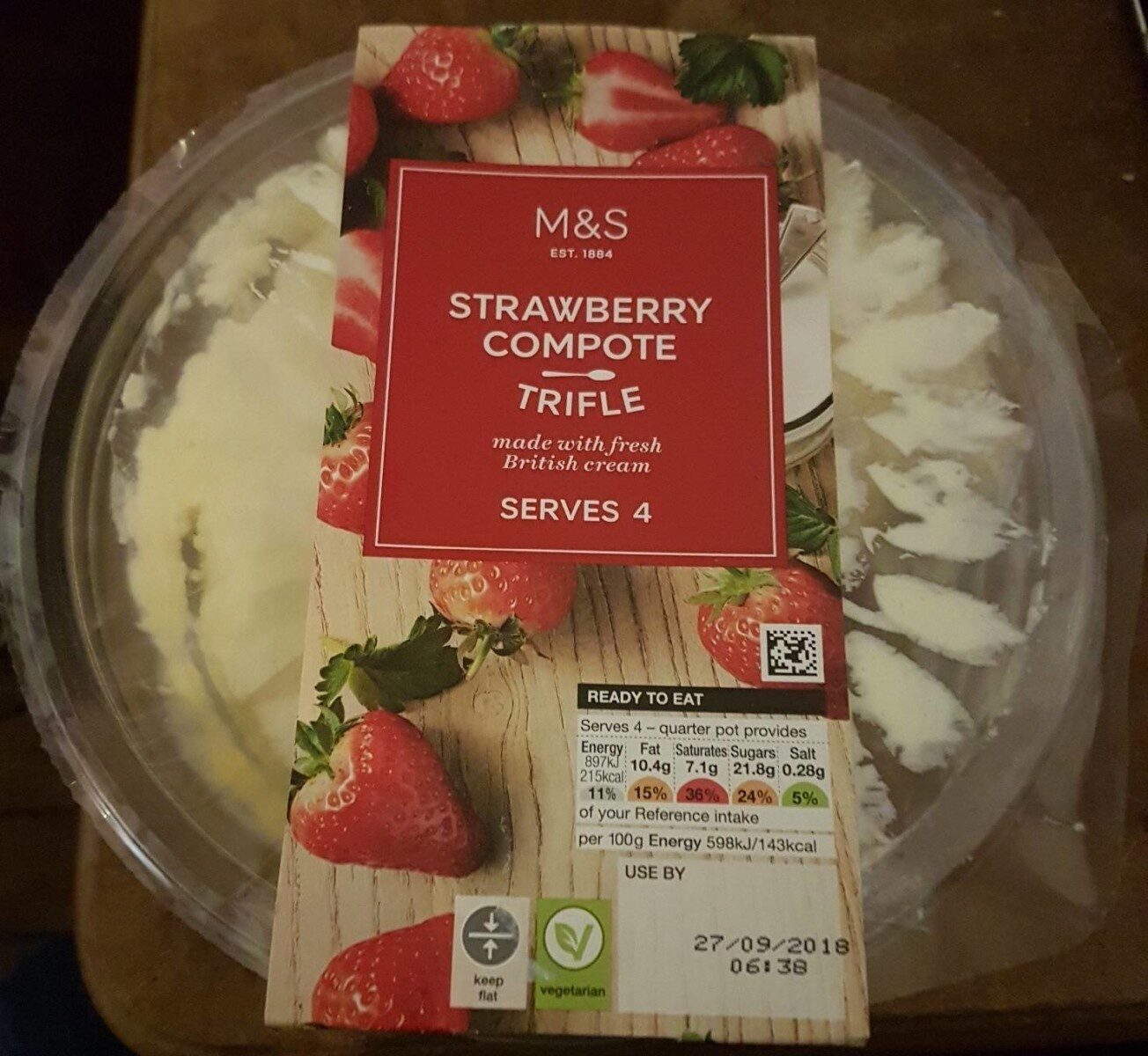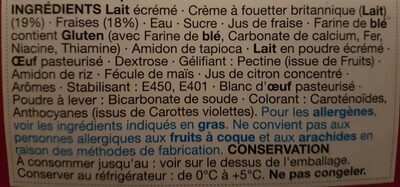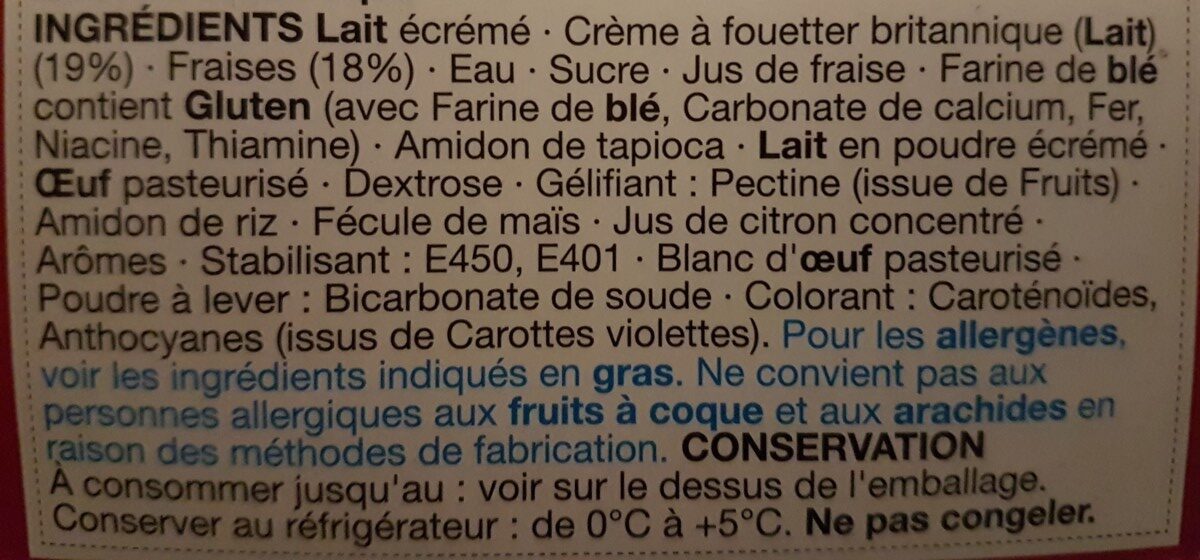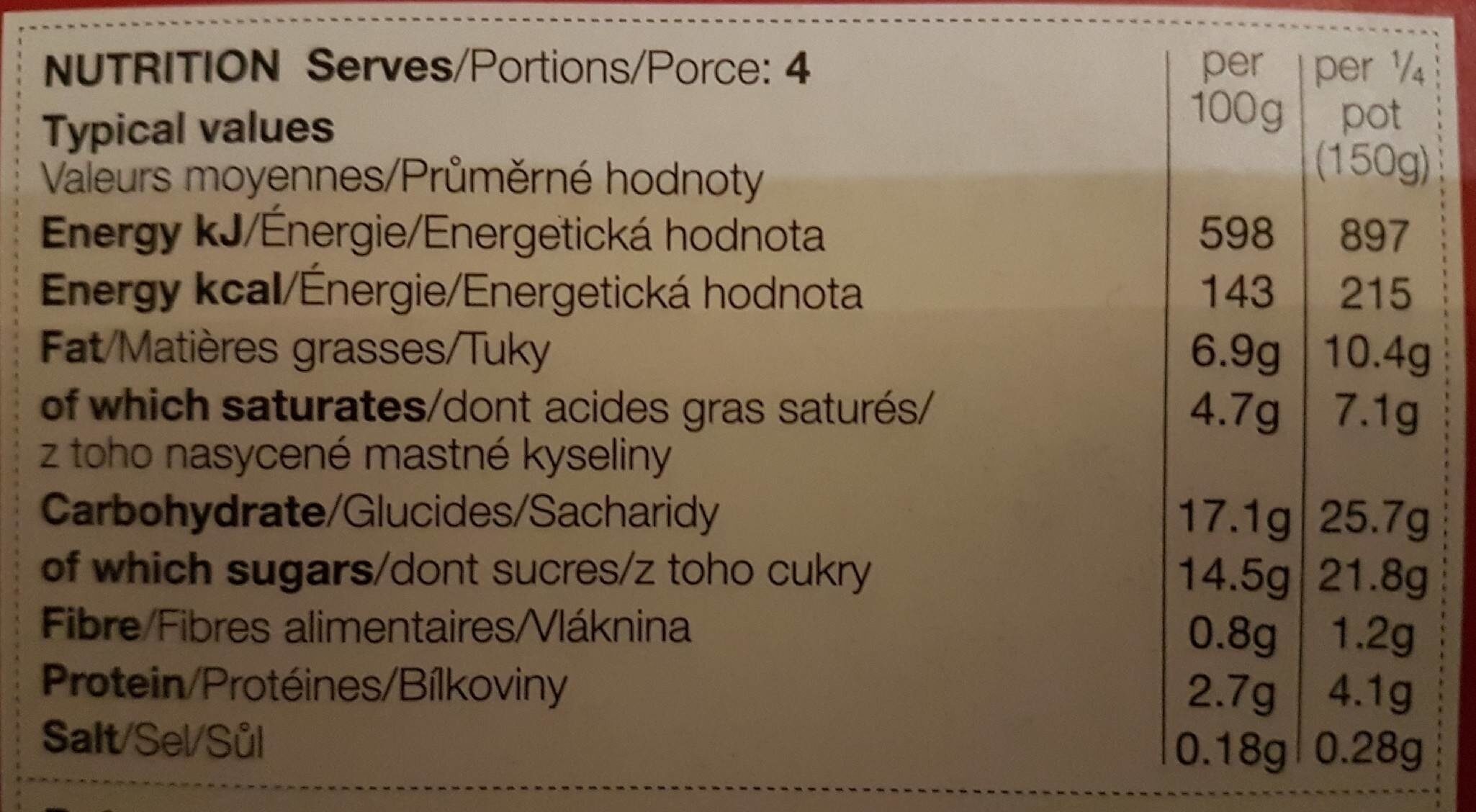Help us make food transparency the norm!
As a non-profit organization, we depend on your donations to continue informing consumers around the world about what they eat.
The food revolution starts with you!
Strawberry compote trifle - M & S - 600 g
Strawberry compote trifle - M & S - 600 g
Ambiguous barcode: This product has a Restricted Circulation Number barcode for products within a company. This means that different producers and stores can use the same barcode for different products.
×
This product page is not complete. You can help to complete it by editing it and adding more data from the photos we have, or by taking more photos using the app for Android or iPhone/iPad. Thank you!
×
Barcode: 00392839
Quantity: 600 g
Brands: M & S
Categories: en:Dairies, en:Desserts, en:Dairy desserts, en:Trifles, fr:Desserts lactés aux œufs
Stores: Marks & Spencer
Countries where sold: An Fhraing, An Rìoghachd Aonaichte
Matching with your preferences
Health
Ingredients
-
34 ingredients
: Lait écrémé • Crème à fouetter (Lait) • Fraises • Sucre • Eau • Lait en poudre écrémé • Farine de blé (contient Gluten) • Jus de fraise • Amidon de tapioca • : Œufs de poules élevées en plen air pasteurisés • Fécule de maïs • Gélifiant : Pectine issue de Fruits) • Amidon de riz • Jus de citron concentré • Humectant : Glycérol • ctosérum en poudre (Lait) • Blanc d'œufs de poules élevées en plein air en poudre • Arômes • Correcteur d'acidité : E327 • Colorant : Caroténoïdes, Anthocyanes Ossus de ; Carottes noires) • Poudre à lever : Bicarbonate de soude, E450 • Stabilisant : Carraghénanes. Pour les allergènes, voir les ingrédients indiqués en gras. Ne convient pas aux personnes allergiques aux fruits à coque et aux arachides en valson des : méthodes de fabrication. CONSERVATIONAllergens: en:Gluten, en:Milk
Food processing
-
Ultra processed foods
Elements that indicate the product is in the en:4 - Ultra processed food and drink products group:
- Additive: E160
- Additive: E163
- Additive: E327
- Additive: E407
- Additive: E422
- Additive: E440
- Additive: E450
- Ingredient: Colour
- Ingredient: Flavouring
- Ingredient: Gelling agent
- Ingredient: Humectant
Food products are classified into 4 groups according to their degree of processing:
- Unprocessed or minimally processed foods
- Processed culinary ingredients
- Processed foods
- Ultra processed foods
The determination of the group is based on the category of the product and on the ingredients it contains.
Additives
-
E163
Anthocyanin: Anthocyanins -also anthocyans; from Greek: ἄνθος -anthos- "flower" and κυάνεος/κυανοῦς kyaneos/kyanous "dark blue"- are water-soluble vacuolar pigments that, depending on their pH, may appear red, purple, or blue. Food plants rich in anthocyanins include the blueberry, raspberry, black rice, and black soybean, among many others that are red, blue, purple, or black. Some of the colors of autumn leaves are derived from anthocyanins.Anthocyanins belong to a parent class of molecules called flavonoids synthesized via the phenylpropanoid pathway. They occur in all tissues of higher plants, including leaves, stems, roots, flowers, and fruits. Anthocyanins are derived from anthocyanidins by adding sugars. They are odorless and moderately astringent. Although approved to color foods and beverages in the European Union, anthocyanins are not approved for use as a food additive because they have not been verified as safe when used as food or supplement ingredients. There is no conclusive evidence anthocyanins have any effect on human biology or diseases.Source: Wikipedia (Beurla)
-
E327
Calcium lactate: Calcium lactate is a white crystalline salt with formula C6H10CaO6, consisting of two lactate anions H3C-CHOH-CO−2 for each calcium cation Ca2+. It forms several hydrates, the most common being the pentahydrate C6H10CaO6·5H2O. Calcium lactate is used in medicine, mainly to treat calcium deficiencies; and as a food additive with E number of E327. Some cheese crystals consist of calcium lactate.Source: Wikipedia (Beurla)
-
E407
Carrageenan: Carrageenans or carrageenins - karr-ə-gee-nənz, from Irish carraigín, "little rock"- are a family of linear sulfated polysaccharides that are extracted from red edible seaweeds. They are widely used in the food industry, for their gelling, thickening, and stabilizing properties. Their main application is in dairy and meat products, due to their strong binding to food proteins. There are three main varieties of carrageenan, which differ in their degree of sulfation. Kappa-carrageenan has one sulfate group per disaccharide, iota-carrageenan has two, and lambda-carrageenan has three. Gelatinous extracts of the Chondrus crispus -Irish moss- seaweed have been used as food additives since approximately the fifteenth century. Carrageenan is a vegetarian and vegan alternative to gelatin in some applications or may be used to replace gelatin in confectionery.Source: Wikipedia (Beurla)
-
E422
Glycerol: Glycerol -; also called glycerine or glycerin; see spelling differences- is a simple polyol compound. It is a colorless, odorless, viscous liquid that is sweet-tasting and non-toxic. The glycerol backbone is found in all lipids known as triglycerides. It is widely used in the food industry as a sweetener and humectant and in pharmaceutical formulations. Glycerol has three hydroxyl groups that are responsible for its solubility in water and its hygroscopic nature.Source: Wikipedia (Beurla)
-
E440
Pectin: Pectin -from Ancient Greek: πηκτικός pēktikós, "congealed, curdled"- is a structural heteropolysaccharide contained in the primary cell walls of terrestrial plants. It was first isolated and described in 1825 by Henri Braconnot. It is produced commercially as a white to light brown powder, mainly extracted from citrus fruits, and is used in food as a gelling agent, particularly in jams and jellies. It is also used in dessert fillings, medicines, sweets, as a stabilizer in fruit juices and milk drinks, and as a source of dietary fiber.Source: Wikipedia (Beurla)
-
E500
Sodium carbonate: Sodium carbonate, Na2CO3, -also known as washing soda, soda ash and soda crystals, and in the monohydrate form as crystal carbonate- is the water-soluble sodium salt of carbonic acid. It most commonly occurs as a crystalline decahydrate, which readily effloresces to form a white powder, the monohydrate. Pure sodium carbonate is a white, odorless powder that is hygroscopic -absorbs moisture from the air-. It has a strongly alkaline taste, and forms a moderately basic solution in water. Sodium carbonate is well known domestically for its everyday use as a water softener. Historically it was extracted from the ashes of plants growing in sodium-rich soils, such as vegetation from the Middle East, kelp from Scotland and seaweed from Spain. Because the ashes of these sodium-rich plants were noticeably different from ashes of timber -used to create potash-, they became known as "soda ash". It is synthetically produced in large quantities from salt -sodium chloride- and limestone by a method known as the Solvay process. The manufacture of glass is one of the most important uses of sodium carbonate. Sodium carbonate acts as a flux for silica, lowering the melting point of the mixture to something achievable without special materials. This "soda glass" is mildly water-soluble, so some calcium carbonate is added to the melt mixture to make the glass produced insoluble. This type of glass is known as soda lime glass: "soda" for the sodium carbonate and "lime" for the calcium carbonate. Soda lime glass has been the most common form of glass for centuries. Sodium carbonate is also used as a relatively strong base in various settings. For example, it is used as a pH regulator to maintain stable alkaline conditions necessary for the action of the majority of photographic film developing agents. It acts as an alkali because when dissolved in water, it dissociates into the weak acid: carbonic acid and the strong alkali: sodium hydroxide. This gives sodium carbonate in solution the ability to attack metals such as aluminium with the release of hydrogen gas.It is a common additive in swimming pools used to raise the pH which can be lowered by chlorine tablets and other additives which contain acids. In cooking, it is sometimes used in place of sodium hydroxide for lyeing, especially with German pretzels and lye rolls. These dishes are treated with a solution of an alkaline substance to change the pH of the surface of the food and improve browning. In taxidermy, sodium carbonate added to boiling water will remove flesh from the bones of animal carcasses for trophy mounting or educational display. In chemistry, it is often used as an electrolyte. Electrolytes are usually salt-based, and sodium carbonate acts as a very good conductor in the process of electrolysis. In addition, unlike chloride ions, which form chlorine gas, carbonate ions are not corrosive to the anodes. It is also used as a primary standard for acid-base titrations because it is solid and air-stable, making it easy to weigh accurately.Source: Wikipedia (Beurla)
-
E500ii
Sodium carbonate: Sodium carbonate, Na2CO3, -also known as washing soda, soda ash and soda crystals, and in the monohydrate form as crystal carbonate- is the water-soluble sodium salt of carbonic acid. It most commonly occurs as a crystalline decahydrate, which readily effloresces to form a white powder, the monohydrate. Pure sodium carbonate is a white, odorless powder that is hygroscopic -absorbs moisture from the air-. It has a strongly alkaline taste, and forms a moderately basic solution in water. Sodium carbonate is well known domestically for its everyday use as a water softener. Historically it was extracted from the ashes of plants growing in sodium-rich soils, such as vegetation from the Middle East, kelp from Scotland and seaweed from Spain. Because the ashes of these sodium-rich plants were noticeably different from ashes of timber -used to create potash-, they became known as "soda ash". It is synthetically produced in large quantities from salt -sodium chloride- and limestone by a method known as the Solvay process. The manufacture of glass is one of the most important uses of sodium carbonate. Sodium carbonate acts as a flux for silica, lowering the melting point of the mixture to something achievable without special materials. This "soda glass" is mildly water-soluble, so some calcium carbonate is added to the melt mixture to make the glass produced insoluble. This type of glass is known as soda lime glass: "soda" for the sodium carbonate and "lime" for the calcium carbonate. Soda lime glass has been the most common form of glass for centuries. Sodium carbonate is also used as a relatively strong base in various settings. For example, it is used as a pH regulator to maintain stable alkaline conditions necessary for the action of the majority of photographic film developing agents. It acts as an alkali because when dissolved in water, it dissociates into the weak acid: carbonic acid and the strong alkali: sodium hydroxide. This gives sodium carbonate in solution the ability to attack metals such as aluminium with the release of hydrogen gas.It is a common additive in swimming pools used to raise the pH which can be lowered by chlorine tablets and other additives which contain acids. In cooking, it is sometimes used in place of sodium hydroxide for lyeing, especially with German pretzels and lye rolls. These dishes are treated with a solution of an alkaline substance to change the pH of the surface of the food and improve browning. In taxidermy, sodium carbonate added to boiling water will remove flesh from the bones of animal carcasses for trophy mounting or educational display. In chemistry, it is often used as an electrolyte. Electrolytes are usually salt-based, and sodium carbonate acts as a very good conductor in the process of electrolysis. In addition, unlike chloride ions, which form chlorine gas, carbonate ions are not corrosive to the anodes. It is also used as a primary standard for acid-base titrations because it is solid and air-stable, making it easy to weigh accurately.Source: Wikipedia (Beurla)
Ingredients analysis
-
en:Palm oil content unknown
Unrecognized ingredients: fr:oeufs-de-poules-elevees-en-plen-air-pasteurises, fr:pectine-issue-de-fruits, fr:ctoserum-en-poudre, fr:blanc-d-oeufs-de-poules-elevees-en-plein-air-en-poudre, fr:anthocyanes-ossus-de, fr:ne-convient-pas-aux-personnes-allergiques-aux-fruits-a-coque-et-aux-arachides-en-valson-des, fr:methodes-de-fabrication, fr:conservationSome ingredients could not be recognized.
We need your help!
You can help us recognize more ingredients and better analyze the list of ingredients for this product and others:
- Edit this product page to correct spelling mistakes in the ingredients list, and/or to remove ingredients in other languages and sentences that are not related to the ingredients.
- Add new entries, synonyms or translations to our multilingual lists of ingredients, ingredient processing methods, and labels.
If you would like to help, join the #ingredients channel on our Slack discussion space and/or learn about ingredients analysis on our wiki. Thank you!
-
en:Non-vegan
Non-vegan ingredients: en:Skimmed milk, en:Whipping cream, en:Skimmed milk powderSome ingredients could not be recognized.
We need your help!
You can help us recognize more ingredients and better analyze the list of ingredients for this product and others:
- Edit this product page to correct spelling mistakes in the ingredients list, and/or to remove ingredients in other languages and sentences that are not related to the ingredients.
- Add new entries, synonyms or translations to our multilingual lists of ingredients, ingredient processing methods, and labels.
If you would like to help, join the #ingredients channel on our Slack discussion space and/or learn about ingredients analysis on our wiki. Thank you!
-
en:Vegetarian status unknown
Unrecognized ingredients: fr:oeufs-de-poules-elevees-en-plen-air-pasteurises, fr:pectine-issue-de-fruits, fr:ctoserum-en-poudre, fr:blanc-d-oeufs-de-poules-elevees-en-plein-air-en-poudre, fr:anthocyanes-ossus-de, fr:ne-convient-pas-aux-personnes-allergiques-aux-fruits-a-coque-et-aux-arachides-en-valson-des, fr:methodes-de-fabrication, fr:conservationSome ingredients could not be recognized.
We need your help!
You can help us recognize more ingredients and better analyze the list of ingredients for this product and others:
- Edit this product page to correct spelling mistakes in the ingredients list, and/or to remove ingredients in other languages and sentences that are not related to the ingredients.
- Add new entries, synonyms or translations to our multilingual lists of ingredients, ingredient processing methods, and labels.
If you would like to help, join the #ingredients channel on our Slack discussion space and/or learn about ingredients analysis on our wiki. Thank you!
-
Details of the analysis of the ingredients
We need your help!
Some ingredients could not be recognized.
We need your help!
You can help us recognize more ingredients and better analyze the list of ingredients for this product and others:
- Edit this product page to correct spelling mistakes in the ingredients list, and/or to remove ingredients in other languages and sentences that are not related to the ingredients.
- Add new entries, synonyms or translations to our multilingual lists of ingredients, ingredient processing methods, and labels.
If you would like to help, join the #ingredients channel on our Slack discussion space and/or learn about ingredients analysis on our wiki. Thank you!
: Lait écrémé, Crème à fouetter, Fraises, Sucre, Eau, Lait en poudre écrémé, Farine de blé, Jus de fraise, Amidon de tapioca (Œufs de poules élevées en plen air pasteurisés, Fécule de maïs, Gélifiant), Pectine issue de Fruits, Amidon de riz, Jus de citron concentré, Humectant (Glycérol, ctosérum en poudre, Blanc d'œufs de poules élevées en plein air en poudre, Arômes, Correcteur d'acidité), e327, Colorant (Caroténoïdes), Anthocyanes Ossus de, Carottes noires, Poudre à lever (Bicarbonate de soude), e450, Stabilisant (Carraghénanes), Ne convient pas aux personnes allergiques aux fruits à coque et aux arachides en valson des (méthodes de fabrication, CONSERVATION)- Lait écrémé -> en:skimmed-milk - vegan: no - vegetarian: yes - ciqual_proxy_food_code: 19051 - percent_min: 4.76190476190476 - percent_max: 100
- Crème à fouetter -> en:whipping-cream - vegan: no - vegetarian: yes - ciqual_food_code: 19402 - percent_min: 0 - percent_max: 50
- Fraises -> en:strawberry - vegan: yes - vegetarian: yes - ciqual_food_code: 13014 - percent_min: 0 - percent_max: 33.3333333333333
- Sucre -> en:sugar - vegan: yes - vegetarian: yes - ciqual_proxy_food_code: 31016 - percent_min: 0 - percent_max: 14.5
- Eau -> en:water - vegan: yes - vegetarian: yes - ciqual_food_code: 18066 - percent_min: 0 - percent_max: 14.5
- Lait en poudre écrémé -> en:skimmed-milk-powder - vegan: no - vegetarian: yes - ciqual_food_code: 19054 - percent_min: 0 - percent_max: 14.5
- Farine de blé -> en:wheat-flour - vegan: yes - vegetarian: yes - ciqual_proxy_food_code: 9410 - percent_min: 0 - percent_max: 14.2857142857143
- Jus de fraise -> en:strawberry-juice - vegan: yes - vegetarian: yes - ciqual_food_code: 13014 - percent_min: 0 - percent_max: 12.5
- Amidon de tapioca -> en:tapioca - vegan: yes - vegetarian: yes - ciqual_proxy_food_code: 9510 - percent_min: 0 - percent_max: 11.1111111111111
- Œufs de poules élevées en plen air pasteurisés -> fr:oeufs-de-poules-elevees-en-plen-air-pasteurises - percent_min: 0 - percent_max: 11.1111111111111
- Fécule de maïs -> en:corn-starch - vegan: yes - vegetarian: yes - ciqual_food_code: 9510 - percent_min: 0 - percent_max: 5.55555555555556
- Gélifiant -> en:gelling-agent - percent_min: 0 - percent_max: 3.7037037037037
- Pectine issue de Fruits -> fr:pectine-issue-de-fruits - percent_min: 0 - percent_max: 10
- Amidon de riz -> en:rice-starch - vegan: yes - vegetarian: yes - ciqual_proxy_food_code: 9510 - percent_min: 0 - percent_max: 9.09090909090909
- Jus de citron concentré -> en:concentrated-lemon-juice - vegan: yes - vegetarian: yes - ciqual_food_code: 2028 - percent_min: 0 - percent_max: 8.33333333333333
- Humectant -> en:humectant - percent_min: 0 - percent_max: 7.69230769230769
- Glycérol -> en:e422 - vegan: maybe - vegetarian: maybe - percent_min: 0 - percent_max: 7.69230769230769
- ctosérum en poudre -> fr:ctoserum-en-poudre - percent_min: 0 - percent_max: 3.84615384615385
- Blanc d'œufs de poules élevées en plein air en poudre -> fr:blanc-d-oeufs-de-poules-elevees-en-plein-air-en-poudre - percent_min: 0 - percent_max: 2.56410256410256
- Arômes -> en:flavouring - vegan: maybe - vegetarian: maybe - percent_min: 0 - percent_max: 1.92307692307692
- Correcteur d'acidité -> en:acidity-regulator - percent_min: 0 - percent_max: 1.53846153846154
- e327 -> en:e327 - vegan: yes - vegetarian: yes - percent_min: 0 - percent_max: 7.14285714285714
- Colorant -> en:colour - percent_min: 0 - percent_max: 6.66666666666667
- Caroténoïdes -> en:e160 - vegan: maybe - vegetarian: maybe - percent_min: 0 - percent_max: 6.66666666666667
- Anthocyanes Ossus de -> fr:anthocyanes-ossus-de - percent_min: 0 - percent_max: 6.25
- Carottes noires -> en:black-carrot - vegan: yes - vegetarian: yes - ciqual_food_code: 20009 - percent_min: 0 - percent_max: 5.88235294117647
- Poudre à lever -> en:raising-agent - percent_min: 0 - percent_max: 5.55555555555556
- Bicarbonate de soude -> en:e500ii - vegan: yes - vegetarian: yes - percent_min: 0 - percent_max: 5.55555555555556
- e450 -> en:e450 - vegan: yes - vegetarian: yes - percent_min: 0 - percent_max: 5.26315789473684
- Stabilisant -> en:stabiliser - percent_min: 0 - percent_max: 5
- Carraghénanes -> en:e407 - vegan: yes - vegetarian: yes - percent_min: 0 - percent_max: 5
- Ne convient pas aux personnes allergiques aux fruits à coque et aux arachides en valson des -> fr:ne-convient-pas-aux-personnes-allergiques-aux-fruits-a-coque-et-aux-arachides-en-valson-des - percent_min: 0 - percent_max: 4.76190476190476
- méthodes de fabrication -> fr:methodes-de-fabrication - percent_min: 0 - percent_max: 4.76190476190476
- CONSERVATION -> fr:conservation - percent_min: 0 - percent_max: 2.38095238095238
Nutrition
-
Average nutritional quality
⚠ ️Warning: the amount of fruits, vegetables and nuts is not specified on the label, it was estimated from the list of ingredients: 12This product is not considered a beverage for the calculation of the Nutri-Score.
Positive points: 1
- Proteins: 1 / 5 (value: 2.7, rounded value: 2.7)
- Fiber: 0 / 5 (value: 0.8, rounded value: 0.8)
- Fruits, vegetables, nuts, and colza/walnut/olive oils: 0 / 5 (value: 12.3007638113839, rounded value: 12.3)
Negative points: 8
- Energy: 1 / 10 (value: 598, rounded value: 598)
- Sugars: 3 / 10 (value: 14.5, rounded value: 14.5)
- Saturated fat: 4 / 10 (value: 4.7, rounded value: 4.7)
- Sodium: 0 / 10 (value: 80, rounded value: 80)
The points for proteins are counted because the negative points are less than 11.
Nutritional score: (8 - 1)
Nutri-Score:
-
Nutrient levels
-
Fat in moderate quantity (6.9%)
What you need to know- A high consumption of fat, especially saturated fats, can raise cholesterol, which increases the risk of heart diseases.
Recommendation: Limit the consumption of fat and saturated fat- Choose products with lower fat and saturated fat content.
-
Saturated fat in moderate quantity (4.7%)
What you need to know- A high consumption of fat, especially saturated fats, can raise cholesterol, which increases the risk of heart diseases.
Recommendation: Limit the consumption of fat and saturated fat- Choose products with lower fat and saturated fat content.
-
Siùcar in high quantity (14.5%)
What you need to know- A high consumption of sugar can cause weight gain and tooth decay. It also augments the risk of type 2 diabetes and cardio-vascular diseases.
Recommendation: Limit the consumption of sugar and sugary drinks- Sugary drinks (such as sodas, fruit beverages, and fruit juices and nectars) should be limited as much as possible (no more than 1 glass a day).
- Choose products with lower sugar content and reduce the consumption of products with added sugars.
-
Salann in low quantity (0.2%)
What you need to know- A high consumption of salt (or sodium) can cause raised blood pressure, which can increase the risk of heart disease and stroke.
- Many people who have high blood pressure do not know it, as there are often no symptoms.
- Most people consume too much salt (on average 9 to 12 grams per day), around twice the recommended maximum level of intake.
Recommendation: Limit the consumption of salt and salted food- Reduce the quantity of salt used when cooking, and don't salt again at the table.
- Limit the consumption of salty snacks and choose products with lower salt content.
-
-
Nutrition facts
Nutrition facts As sold
for 100 g / 100 mlCompared to: en:Trifles Lùth 598 kj
(143 kcal)-19% Fat 6.9 g -10% Saturated fat 4.7 g - Carbohydrates 17.1 g -13% Siùcar 14.5 g -6% Fiber 0.8 g +11% Proteins 2.7 g +1% Salann 0.2 g +26% Fruits‚ vegetables‚ nuts and rapeseed‚ walnut and olive oils (estimate from ingredients list analysis) 12.301 %
Environment
-
Eco-Score not computed - Unknown environmental impact
We could not compute the Eco-Score of this product as it is missing some data, could you help complete it?Could you add a precise product category so that we can compute the Eco-Score? Add a category
Packaging
-
Missing packaging information for this product
⚠ ️ The information about the packaging of this product is not filled in.Take a photo of the recycling information Take a photo of the recycling information
Transportation
-
Origins of ingredients
Missing origins of ingredients information
⚠ ️ The origins of the ingredients of this product are not indicated.
If they are indicated on the packaging, you can modify the product sheet and add them.
If you are the manufacturer of this product, you can send us the information with our free platform for producers.Add the origins of ingredients for this product Add the origins of ingredients for this product
Report a problem
-
Incomplete or incorrect information?
Category, labels, ingredients, allergens, nutritional information, photos etc.
If the information does not match the information on the packaging, please complete or correct it. Open Food Facts is a collaborative database, and every contribution is useful for all.
Data sources
Product added on by kiliweb
Last edit of product page on by roboto-app.
Product page also edited by autorotate-bot, moon-rabbit, openfoodfacts-contributors, tacite-mass-editor, teolemon, yuka.R281ZlFLOEQrNmdGaDhFbTRBNk5vOUZhbmJYM1JXYXhOZm9vSVE9PQ, yuka.YmJrck5JVU0rNklKblBRQm9objMwZFZLbDVTWEFUeWJDL0pBSUE9PQ, yuka.sY2b0xO6T85zoF3NwEKvlmpbbdGBswrFFDrUlXyq797UfsW4U81ivqPDMqs.
